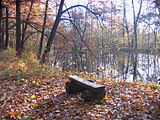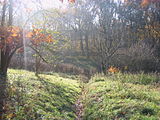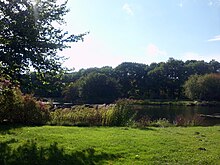Parks in Cottbus
The following article lists the various parks in the city of Cottbus .
history
As early as the end of the 19th century, the city fathers, with the help of the Beautification Association, tried to loosen up Cottbus by creating squares and parks. The first designed square was built in 1813 on the western end of the Luckauer Wall. It was expanded in 1886 and developed into today's Pushkin Promenade over the next century . In 1895, today's Goethepark was built on Mühleninsel. The Elias Park was created by a foundation of the Elias Commerce Council in 1902. The groundbreaking ceremony for the Volkspark, at that time “Kaiser-Wilhelm-Auguste-Viktoria-Hain”, took place in 1909. As a forest recreation area close to the city, the park was intended to provide relaxation for the citizens. The Carl-Blechen-Park, on the eastern bank of the Spree, right next to the Goethepark, was designed in 1930 in honor of the landscape painter. Branitzer Park has also been part of Cottbus since 1934 through incorporation. This was followed by the construction of the spring garden in 1954, the design of the Schillerplatz square in 1956, the design of the Brunschwigpark and the Käthe-Kollwitz-Park in 1970 and the Spreeauenpark for the Federal Horticultural Show in 1995 . Most of the parks are connected by hiking trails along the Spree and form a green recreational area that runs through the entire city.
Branitz Park
The Branitzer Park is considered to be the most important park in Cottbus. Hermann Fürst von Pückler had trees and bushes removed from the Branitz Park for his park in Bad Muskau since 1819 . It was only when he had to sell this property because of high debts that he reluctantly moved to Branitz . From 1846 he began to design the Branitz Park. After his death in 1871, his successor Heinrich Graf von Pückler continued the work until 1888. Hermann Fürst von Pückler created a landscape garden here with design differentiated park areas. The park is divided into three zones, the pleasure ground , in the center of which the castle is located, the indoor park and the outdoor park. Today the zoo and the Spreeauenpark are located in the area of the outdoor park . The outdoor park extends over an area of approx. 600 hectares and consists of forest, meadow and arable land. The inner park is about 100 hectares and was transformed by Hermann Fürst von Pückler through extensive earth movements into a composition of winding paths, ponds, hills and watercourses with many bridges. He designed the park effectively with tree and woody plantings that repeatedly reveal lines of sight to the castle. While only native plants were used in the park area, he also used foreign trees in the Pleasureground. Between 1855 and 1857 Pückler had the pyramid lake excavated and the burial mound on which the lake pyramid was built was filled with the earth. The land pyramid was created between 1860 and 1863.
Hermann Fürst von Pückler found his final resting place in the burial mound, the tumulus , in 1871 . In 1884 the remains of his wife and partner Lucie von Pückler-Muskau were reburied from the old Branitz cemetery in the lake pyramid.
The center of the park is the Branitz Castle , built in the late Baroque style in 1772 , which Pückler had Gottfried Semper rebuilt according to his own ideas and suggestions . Opposite the castle are the stables and the cavalier house . Both buildings are connected by a pergola with reliefs by the Danish sculptor Berthel Thorwaldsen. In the Pleasureground there are also antique zinc cast copies and the bronze cast of the Venus Italica by Canova. Other buildings worth seeing in the inner park are the neo-Gothic Parkschmiede, the neo- Gothic Cottbus gatehouse and the historic palace gardening facility. Three oriental rooms in the palace are reminiscent of Pückler's travels to the Orient . The castle also houses a library and some of the original rooms from the time of the prince. In addition to an exhibition with the works of the Cottbus-born painter Carl Blechen , various special exhibitions are held. In the visitor center, a modern exhibition with multimedia effects tells of the life of the prince.
Brunschwigpark
The Brunschwigpark was created as a residential park in the 1970s. It is located between Hallenser Strasse and Erfurter Strasse, or Berliner Strasse . The park extends in an east-west direction between Schweriner Strasse and Lessingstrasse or Lieberoser Strasse. After the park was beautified with new plantings in 2006, the park was enlarged in 2008 by designing and greening fallow areas. The park is located on the Gurken cycle path and is part of the city's middle green ring.
Carl Blechen Park
The Carl Blechen Park was created after 1930 and is dedicated to the landscape painter Carl Blechen , who was born in Cottbus in 1798 . The park shows itself with rare trees and flowering perennials on the east side of the Spree . In the fifties the park was connected to the Goethepark by a bridge, today the bridge is called Blechensteg. In 1957, a bronze memorial was erected in honor of Carl Blechen, but it was stolen by metal thieves in February 2008 . The Kastanienallee is continued in the Rosenufer created in 1934/35, today Ludwig-Leichhardt-Allee, a promenade south of the park, separated from it by Franz-Mehring-Straße. A chestnut avenue leads from the Kleiner Spreewehr to Lindenplatz with the space flight planetarium “Juri Gagarin” . In the 70s / 80s there was a thatched pavilion in the park that was used as a snack. An open-air theater, which was demolished in 1995, was also part of the park.
Spring garden
Originally there was only one avenue of chestnut trees along the mill ditch. The spring garden was laid out for the first district garden show in 1954. It was designed with spring flowers and exotic tree species such as holly , ginkgo , sweet chestnut , tulip tree , Japanese quince and the first Cottbus jungle sequoia tree . The spring garden is a special garden monument due to the beautiful use of natural stone, the grasses and shrubs, sculptures, pergolas, the rare exotic trees and the optical inclusion of the Spree. Nutrias have also made their home in and around the Mühlengraben .
Goethe Park
The Goethepark is located in the Sandow district on Franz-Mehring-Straße. It is bordered on three sides by the Spree and connected to the Carl-Blechen-Park by the sheet metal bridge. The facility was laid out in 1895 as a city park by the Beautification Association on the swampy terrain of the Mühleninsel, making it the oldest park in Cottbus. With the construction of the power station in 1926/27, two new ways of accessing the park were created, the bridge at the power station and the bridge to the street “Am Spreeufer”.
It was not until 1949 that the city park was renamed Goethepark. In the spacious park is the Amtsteich, which was used for carp farming around 1600 and in which a fountain gushes today.
In winter the frozen lake is a popular place for ice skaters. A children's playground and the Dieselkraftwerk art museum as well as the museum for nature and the environment make the park an attraction in every season. The restaurant "Freizeitoase" offers the possibility of bowling and bowling. The bank areas are tastefully planted, the park has been preserved in its 1900 form. For many visitors, the nutrias that live here are a small attraction.
Käthe-Kollwitz-Park
The park, named after Käthe Kollwitz , is located in the Sandow district between the Nordring, the Spree and the allotment garden “Diligent Hand”. After the Sandow garbage dump was filled in in 1969 and turned into a toboggan hill, the twenty-hectare Käthe-Kollwitz-Park was created in the following year by creating a network of hiking trails around the eighty-eight meter high toboggan hill. After 1980 the park maintenance continued to decline until after 1990 it was left to its own devices and completely overgrown. Since 2009, employees of the Kolkwitz Nature Conservation Union have endeavored to make the park, which is a local recreation area, usable again for walkers and joggers. The toboggan hill should be able to be used as such again and mountain bikers should also get their money's worth here.
Pushkin Promenade
The Pushkin Promenade runs along the entire north side of the old town. The park is named after the Russian poet Alexander Sergejewitsch Pushkin and is located on the former Luckauer Wall.
In 1744, two thousand mulberry trees were grown on the city moat . They were intended for the planting of public squares, streets and walls. The first small square was designed in 1813 at the western end of the Luckauer Wall. The names "Wallpromenade" and "Promenadenallee" appear for the first time in 1829, when the city's magistrate leased the remaining mulberry trees.
After 1830, gardens were laid out between the city wall and the inner city moat. In the area of the memorial for the fallen in the wars of 1864, 1866 and 1870/71, which was removed in 1964, the Beautification Society, founded in 1872, had its first modest jewelry facility built. In 1886, the Luckauer Wall was redesigned into a typical Wilhelminian style with paths, rondelles and ornamental plantings that were bordered by low hedges. The jewelry complex with the "Japanese Pavilion" was added in 1905 at the western end.
Gardens were still preserved after 1945 in the hollow between the Luckauer Wall and the inner city moat. In the two-year “Debris Removal” plan, this area was almost completely backfilled in 1949/50 with the debris from the war ruins. In June 1949 the promenade was given its current name. The redesign of the promenade and the backfilled areas into a continuous green area took place in 1956/57. In 1968, an ice rink was built in a preserved area of the pit in the eastern part of the promenade. A pile of rubble and garbage was formed into a toboggan hill, planted and made accessible with paths.
In the following decades the Pushkin promenade was redesigned again and again. Numerous seats, herbaceous borders, natural stone walls and slab surfaces were created, which were connected by an angular system of paths. Outdoor chess, a water garden and fountains were integrated into the concept.
The toboggan hill, paved areas with play equipment and table tennis tables as well as extensive sand play areas destroyed the park character of the Pushkin Promenade. On the occasion of the 30th anniversary of the GDR , the honorary grove for the victims of fascism and militarism was inaugurated in the area of the former water garden. Numerous sculptures of the IX. International Hoyerswerda Sculpture Symposium were set up in the park in 1981.
In 1995, the trees and shrubs were renewed in preparation for the Federal Garden Show. The paths, plazas, natural stone walls and fountains were renovated, whereby the oversized play areas were relocated and reduced in size. To give the promenade its park character back, the
Garden architects the subsequently introduced paths and places. Removal of the toboggan hill and the sealed ice rink failed because of the horrific costs, as the ground in this area is heavily contaminated with heavy metals .
Schillerplatz
Schillerplatz is located near the Cottbus State Theater. The square was previously used as a cattle market and parade ground. Around 1900 the square was rebuilt with representative town houses and the Art Nouveau theater . Until 1943 it was still used as a fairground. On the occasion of the 800th anniversary of the city of Cottbus, the square was given its present shape in 1956 with numerous trees, plant species and a large fountain. It is one of the landmarks of the city of Cottbus.
Spreeauenpark
The Spreeauenpark, which was created on the occasion of the Federal Horticultural Show in 1995, has joined the Cottbus park area on the Spree with an area of 55 hectares. It is located between the zoo and the Stadium of Friendship . It is divided into a pharmacy and farm garden, a rose garden, the rhododendron grove and a sound garden, all of which are grouped around the 1.2 hectare park pond. Oak avenues, ditches lined with wild shrubs and extensive meadows connect the areas. The tertiary forest, a living replica of a primeval forest from the lignite age around 10 million years ago, with a fossil sequoia stump, coal bog and an avenue of boulders , was created unique in Europe . Family-friendly adventure playgrounds, a park café and the connection to the park railway expand the offer. The park pavilion has established itself as an event stage for parties, open-air events and fire productions. The largest exhibition and conference center in the state of Brandenburg is located in the middle of the park area. A caravan stand has been created for camping enthusiasts near the zoo . A visit to the park is linked to an entrance fee of one euro.
Volkspark
The Volkspark with the Madlower gorges and the oak park is bordered to the west by Bautzener Straße and east by the Spree. To the north it stretches to the “Eichenpark” street and ends to the south just behind the Madlower bathing lake.
The forest recreation area close to the city is criss-crossed by numerous hiking trails and bike-hiking trails. A nature trail was laid out and a swimming lake that is now unguarded is very popular. In 1906 the city council voted for a "forest park" in the Madlower Heide. The then Lord Mayor Paul Werner named it "Kaiser-Wilhelm-Auguste-Viktoria-Hain". An initial design was implemented in 1909, although the farmers who owned the land were not expropriated until 1913. By removing sand and gravel to fill the embankment of the Cottbus- Görlitz railway line , the typical deepenings of the Madlower gorges were created. The name Volkspark, brought into circulation by the Beautification Association, finally caught on around 1918. In 1954 the Volkspark was declared a landscape protection area. For the construction of the city ring, soil was removed again from the spring of 1969 and the Madlower bathing lake was created from the deepening that resulted from this until May 1972. Only dry trenches remain from the former artificial watercourses. Refuge huts, railings and a “chicken ladder” wooden bridge that were built at that time have also disappeared.
More parks and green spaces
- Cottbus Zoo
- Green area on the Cottbuser Schlossberg
- Sachsendorfer meadows
Web links
literature
- Historic green in Cottbus and the Federal Garden Show, Cottbus home calendar 1995, Brandenburgische Denkmalpflege, Volume 4, Issue 1 1995
- Ortschronik Branitz history and stories, Dr. Hartmut Schatte, Manfred Kunath
Individual evidence
- ↑ http://www.pueckler-museum.de/index.php?option=com_content&view=article&id=1&Itemid=10&lang=de
- ↑ Archived copy ( Memento of the original dated February 11, 2013 in the Internet Archive ) Info: The archive link was inserted automatically and has not yet been checked. Please check the original and archive link according to the instructions and then remove this notice.
- ↑ Archived copy ( Memento of the original from April 5, 2013 in the Internet Archive ) Info: The archive link was inserted automatically and has not yet been checked. Please check the original and archive link according to the instructions and then remove this notice.
- ↑ http://www.brandenburg-info.com/spreenei/f_branitz.htm
- ↑ http://www.lr-online.de/regionen/cottbus/Neue-Rosen-und-Baenke-am-Brunschwigpark;art1049,1277575
- ↑ http://www.lr-online.de/regionen/cottbus/62-neue-Baeume-fuer-den-Brunschwigpark;art1049,2169050
- ↑ http://www.lr-online.de/regionen/cottbus/Brunschwigpark-soll-gruener-haben;art1049,2077839
- ↑ http://www.cottbus.de/gaeste/wissenswertes/Parke_Cottbus/blechenpark,40000050.html
- ↑ http://der-lausitzer.de/2010/06/26/cottbus-der-blechenpark-mit-dem-reetgedeckten-kiosk-und-der-freilichtbhne-war-an-sonntagen-beliebter-treffpunkt/
- ↑ http://www.stadtspaziergaenge.de/2004/gruen/druckversionen/cottbus.html
- ↑ http://www.geocaching.com/seek/cache_details.aspx?guid=6c22bf7b-2b31-4a3c-82f1-39f2a500f1ae
- ↑ http://www.cottbus.de/gaeste/wissenswertes/Parke_Cottbus/blechenpark,40000050.html
- ↑ http://www.cottbus.de/gaeste/wissenswertes/Parke_Cottbus/goethepark,40000054.html
- ↑ http://tourismus.meinestadt.de/cottbus/parks-und-gaerten/parks-und-gaerten-cottbus?id=311195
- ↑ http://www.lr-online.de/regionen/cottbus/Kollwitz-Park-bietet-Raum-fuer-Vogelwelt-und-Mountainbikes;art1049,2879587
- ↑ http://www.rodelberge.de/index.php?content=show&id=188
- ↑ http://www.lr-online.de/regionen/cottbus/Cottbuser-Kollwitzpark-soll-wieder-aufgepeppt-haben;art1049,2144564
- ↑ http://www.stadtspaziergaenge.de/2007/cott_mehl.php
- ↑ Pushkin Promenade (Cottbus )
- ↑ http://www.cottbus.de/gaeste/wissenswertes/altstadtrundgang/schillerplatz,255013185.html
- ↑ Archived copy ( memento of the original from July 23, 2012 in the Internet Archive ) Info: The archive link was inserted automatically and has not yet been checked. Please check the original and archive link according to the instructions and then remove this notice.
- ↑ http://www.cmt-cottbus.de/spreeauenpark.html
- ↑ http://www.lr-online.de/regionen/cottbus/Der-Cottbuser-Spreeauenpark-soll-seinen-Zaun-behalten;art1049,3560905
Coordinates: 51 ° 45 ′ 36.3 ″ N , 14 ° 20 ′ 24 ″ E














